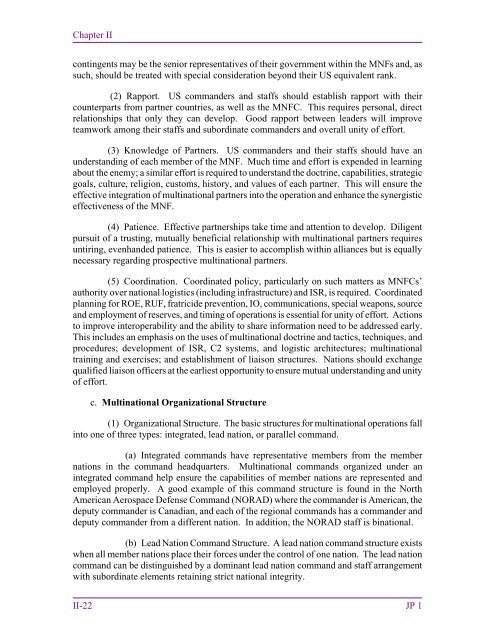JP 1, Doctrine for the Armed Forces of the United States - Defense ...
JP 1, Doctrine for the Armed Forces of the United States - Defense ...
JP 1, Doctrine for the Armed Forces of the United States - Defense ...
You also want an ePaper? Increase the reach of your titles
YUMPU automatically turns print PDFs into web optimized ePapers that Google loves.
Chapter II<br />
contingents may be <strong>the</strong> senior representatives <strong>of</strong> <strong>the</strong>ir government within <strong>the</strong> MNFs and, as<br />
such, should be treated with special consideration beyond <strong>the</strong>ir US equivalent rank.<br />
(2) Rapport. US commanders and staffs should establish rapport with <strong>the</strong>ir<br />
counterparts from partner countries, as well as <strong>the</strong> MNFC. This requires personal, direct<br />
relationships that only <strong>the</strong>y can develop. Good rapport between leaders will improve<br />
teamwork among <strong>the</strong>ir staffs and subordinate commanders and overall unity <strong>of</strong> ef<strong>for</strong>t.<br />
(3) Knowledge <strong>of</strong> Partners. US commanders and <strong>the</strong>ir staffs should have an<br />
understanding <strong>of</strong> each member <strong>of</strong> <strong>the</strong> MNF. Much time and ef<strong>for</strong>t is expended in learning<br />
about <strong>the</strong> enemy; a similar ef<strong>for</strong>t is required to understand <strong>the</strong> doctrine, capabilities, strategic<br />
goals, culture, religion, customs, history, and values <strong>of</strong> each partner. This will ensure <strong>the</strong><br />
effective integration <strong>of</strong> multinational partners into <strong>the</strong> operation and enhance <strong>the</strong> synergistic<br />
effectiveness <strong>of</strong> <strong>the</strong> MNF.<br />
(4) Patience. Effective partnerships take time and attention to develop. Diligent<br />
pursuit <strong>of</strong> a trusting, mutually beneficial relationship with multinational partners requires<br />
untiring, evenhanded patience. This is easier to accomplish within alliances but is equally<br />
necessary regarding prospective multinational partners.<br />
(5) Coordination. Coordinated policy, particularly on such matters as MNFCs’<br />
authority over national logistics (including infrastructure) and ISR, is required. Coordinated<br />
planning <strong>for</strong> ROE, RUF, fratricide prevention, IO, communications, special weapons, source<br />
and employment <strong>of</strong> reserves, and timing <strong>of</strong> operations is essential <strong>for</strong> unity <strong>of</strong> ef<strong>for</strong>t. Actions<br />
to improve interoperability and <strong>the</strong> ability to share in<strong>for</strong>mation need to be addressed early.<br />
This includes an emphasis on <strong>the</strong> uses <strong>of</strong> multinational doctrine and tactics, techniques, and<br />
procedures; development <strong>of</strong> ISR, C2 systems, and logistic architectures; multinational<br />
training and exercises; and establishment <strong>of</strong> liaison structures. Nations should exchange<br />
qualified liaison <strong>of</strong>ficers at <strong>the</strong> earliest opportunity to ensure mutual understanding and unity<br />
<strong>of</strong> ef<strong>for</strong>t.<br />
c. Multinational Organizational Structure<br />
(1) Organizational Structure. The basic structures <strong>for</strong> multinational operations fall<br />
into one <strong>of</strong> three types: integrated, lead nation, or parallel command.<br />
(a) Integrated commands have representative members from <strong>the</strong> member<br />
nations in <strong>the</strong> command headquarters. Multinational commands organized under an<br />
integrated command help ensure <strong>the</strong> capabilities <strong>of</strong> member nations are represented and<br />
employed properly. A good example <strong>of</strong> this command structure is found in <strong>the</strong> North<br />
American Aerospace <strong>Defense</strong> Command (NORAD) where <strong>the</strong> commander is American, <strong>the</strong><br />
deputy commander is Canadian, and each <strong>of</strong> <strong>the</strong> regional commands has a commander and<br />
deputy commander from a different nation. In addition, <strong>the</strong> NORAD staff is binational.<br />
(b) Lead Nation Command Structure. A lead nation command structure exists<br />
when all member nations place <strong>the</strong>ir <strong>for</strong>ces under <strong>the</strong> control <strong>of</strong> one nation. The lead nation<br />
command can be distinguished by a dominant lead nation command and staff arrangement<br />
with subordinate elements retaining strict national integrity.<br />
II-22 <strong>JP</strong> 1

















